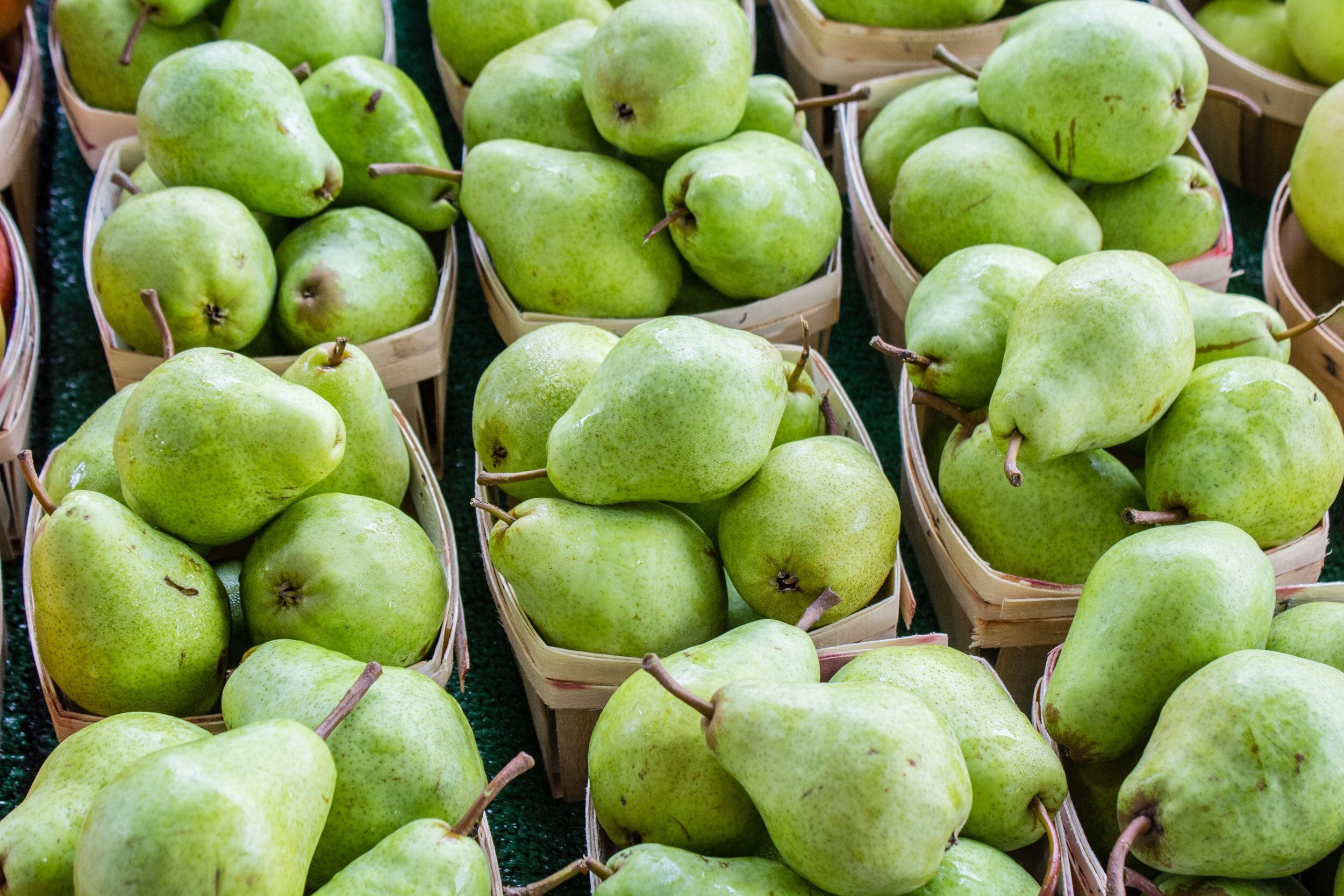Energetics of Pears: 3,000 Years of Deliciousness
Originating from Central Asia, the pear has been around for over 3,000 years. In the epic The Odyssey, Homer refers to pears as the “gift of the gods”. Pears were then brought to America by the early colonists and the first pear tree was planted in 1620. Since then they have been one of America’s more popular fruits.
Varieties
There are thousands of varieties of pears and they come in all shapes, sizes, colors, flavors, and shelf life. While there are many types found around the world, in the US there are only a few types that are commonly found. The good news is that many varieties found in other countries are rising in popularity in the US.
Anjou pears are slightly stubby, oval-shaped with smooth, yellow-green skin and creamy flesh. This is the most abundant of the winter pears. Bartlett pears are large, juicy summer pears that turn from dark green to golden-yellow when ripe. They are primarily used in canning and exclusively used for drying. Bosc pears are characterized by their long tapered neck and rough reddish-brown skin. They have a firm, crunchy texture, which makes them perfect for baking and poaching. Comice pears are squat-shaped, dull-green colored. It is often considered the sweetest and most flavorful of the common pear varieties.
Pears are available year-round, with some varieties being the most flavorful in summer and some in winter. However, the peak of their season runs from August to October.
How To Choose and Store
When you are at the store you will notice that most pears are hard when you squeeze them, this is because pears perish fast when ripe and so they harvest them very unripe. So make sure to allow time for your pears to soften after purchase.
When shopping, look for pears that are firm but not too hard. They should also be free of bruises and mold. There is no need to look for uniform colors, as there are many varieties that have multiple colors or are speckled. Fully ripened pears will be juicy, flavorful, and ready to eat once they yield to gentle pressure. They have the best taste when enjoyed at room temperature. You can enjoy pears ripe or unripe, as both are delicious and nutritious. I personally like my pears unripe, as I enjoy a crunchier pear to a soft pear.
Avoid overripe pears, which should not be eaten as they have lost all nutritional value and have formed free radicals. They are characterized by being super soft and brown.
Fresh tree-ripened pears can last up to 3 days if stored in a fridge. If left at room temperature they will spoil more quickly. If you purchase unripe pears, you can ripen them by leaving them on the counter standing upright on a flat surface with space between fruit. This process will take 3-5 days and they will be ready when soft and yield to gentle pressure. Be careful where you store your pears as excess heat will cause pears to rot rather than ripen.
Nutrition
Pears are surprisingly heart-healthy due to their high amounts of vitamin C and a wide variety of flavonoids. Vitamin C and flavonoids have a synergistic relationship, each helping to improve the antioxidant potential of the other. Vitamin C helps to protect cells from oxygen-related damage due to free radicals. Additionally, pears are packed with phytosterols, phytonutrients that have been shown to inhibit cholesterol absorption. They are also a good source of copper, a mineral that helps protect the body from free radicals, via its role as a component in superoxide dismutase (SOD). SOD is an enzyme that helps eliminate superoxide free radicals which are common and formed during normal metabolism and when white blood cells attack pathogens. Pears are also an excellent source of fiber, which not only helps prevent constipation and ensures the regularity of the bowels, but can help bind to toxins in the bowels that can cause colon cancer.
Pears have been shown to be hypoallergenic. They have been recommended for the first introduction of fruits to infants.
Energetics
Pears are cool in temperature and tend to be sweet and slightly sour in flavor. Pears are known to benefit the lungs by eliminating heat and transforming mucus (due to its sour and astringent nature). Pears are also moistening and thus stop coughs associated with hot, dry lungs or throat, and help with dryness in the upper body in general. Pears are often used to treat a stubborn dry persistent cough after a febrile disease, such as cold/flu. The cooling and moistening nature also make the pear good at quenching thirst when the thirst is from a heat disorder. Pears and watermelon make a great after sun snack to help cool down, quench thirst, regenerate healthy fluids.
It has traditionally been used in the treatment of diabetes (wasting & thirsting in TCM), injures to the skin, constipation, loss of voice, and gallbladder inflammation and obstruction.
Caution: Not for those with deficient digestive fire. Symptoms include loose or watery stool, signs of coldness, and a swollen, pale tongue. Excessive use of pears during pregnancy may cause poor fetal development and miscarriage.
Pear & Pomegranate Lamb Tagine
Ingredients
2-1/2 pounds lamb shanks
2 large pears, finely chopped
3 cups thinly sliced shallots
1/2 cup orange juice, divided
1/2 cup pomegranate juice, divided
1 tablespoon honey
1-1/2 teaspoons ground cinnamon
1 teaspoon salt
1 teaspoon ground allspice
1 teaspoon ground cardamom
1/4 cup pomegranate seeds
1/4 cup minced fresh parsley
Cooked couscous, optional
Preparation
Place lamb in a 5- or 6-qt. oval slow cooker. Add pears and shallots. Combine 1/4 cup orange juice, 1/4 cup pomegranate juice, honey and seasonings; add to slow cooker.
Cook, covered, on low until meat is tender, 6-8 hours. Remove lamb to a rimmed serving platter; keep warm. Stir remaining orange and pomegranate juices into cooking liquid; pour over lamb. Sprinkle with pomegranate seeds and parsley. If desired, serve over couscous.
Source
https://www.tasteofhome.com/recipes/pear-and-pomegranate-lamb-tagine/
Mateljan, George. The World’s Healthiest Foods: Essential Guide for the Healthiest Way of Eating. George Mateljan Foundation: Seattle, 2007. Print.
Pitchford, Paul. Healing with Whole Foods: Oriental Traditions and Modern Nutrition. North Atlantic Books: Berkeley, 1993. Print.




